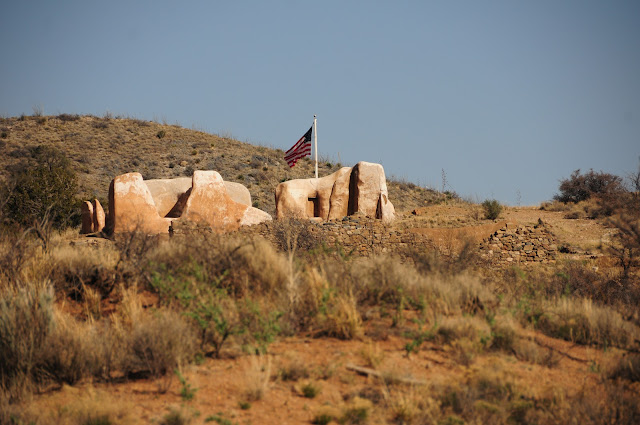Yesterday afternoon we experienced a most enjoyable walk in the park.
Fort Bowie is about 116 miles east of Tucson. From Wilcox we took Highway 186 southeast about 20 miles.
After turning left off 186 the last eight miles to the trailhead were not paved.
It is not a difficult hike... about 3 miles round trip. But with stopping often to take about 300 photos it took us 3 hours. If I had it to do again I would plan to stay longer... but we started too late and the sun was setting, so we hurried back to our car.
The signage in this park is exceptional and tells the history and details very clearly. Fort Bowie was established to protect a small but important water source, Apache Spring... and also to protect this mountain pass, which was the shortest route between El Paso and Tucson. In addition the fort was used to assist the engineers who were staking out the best route for the new railway across the land.
Apache Spring is just a trickle today... but they have an encatchment above this little water fall to supply the Visitors Centre. Apparently water in these parts is pretty scarce and travellers soon learned where they could fill up their canteens... and where the next water could be found.
This old photo shows all the buildings at the second location of Fort Bowie... it was a bustling centre.
and this is what it looks like today. All that remains are the foundations and a few masonry walls.
I was so excited to see this flag behind these structures I headed off the trail to get the best possible angle. This shot was taken with full zoom on the 18-200 mm telephoto... so it was still pretty far away.
Shirley meanwhile was taking a picture of me breaking the first rule on the sign... "Stay on Trail." I was pretty careful not to walk on any plants... especially those prickly pear cactus.
On a lower plateau, which was not nearly as level or large, we investigated the original fort site.
Every foundation had a sign identifying it.
This photo shows part of the original fort site in the foreground and the final site on the horizon to left.
From this original site looking back over the land we have traversed we can see the cemetery on a plateau left centre.... the Stage Station ruins just right of centre on the plateau. The tallest mountain in the background is Government Peak.
Originally 99 souls were buried here... but 72 soldiers were removed for reinternment at the San Francisco National Cemetery, leaving 23 civilian graves.
There were several battles with the Apache Indians... hence most of those buried here were not very old.
It was amazing to see Geronimo's son, Little Robe, age 2, buried here.
The Stage Station was built long before Fort Bowie, in 1858.
It was here the stage coaches would stop to rest and have a meal for 50 cents... bread, coffee, meat and beans. There were also rooms to stay overnight here.
In 1857 the US government awarded John Butterfield a contract to carry mail between St. Louis and San Francisco... a 2800 mile route that took 25 days to travel each way. Butterfield charged his men, "Remember boys, nothing on God's earth must stop the United States mail." Little did he know of the hassles those Apaches would give him.
This foundation was for the Chiricahua Apache Indian Agency... an onsite office to deal with Indian affairs. US. agent Thomas Jeffords governed some 900 Apaches in the mid 1870's until the Indian chief died. The tribe was split and in 1876 the government decided to move about 375 to the San Carlos reservation... but most of those soon left there too.
The Apaches used to live in these thatched wickiups... which were covered with bear grass and animal hides. During the hottest summer days the covered ramada gave them some relief from the sun.
Fort Bowie was named after George Washington Bowie, a Colonel of the 5th California infantry. On the right is General James Carleton who led the attack against the Apaches and founded the first "Fort Bowie."
Shirley caught me in front of this most significant stone building used for guns and artillery.
Powder Magazine, 1890
Every quarter mile along the trail is a marking post that helps hikers know how far they have come and how far yet to go. This marked the end of the main trail to get to Fort Bowie.
Since there are just too many great photos from this site, stay tuned for Part II of Fort Bowie.

























No comments:
Post a Comment